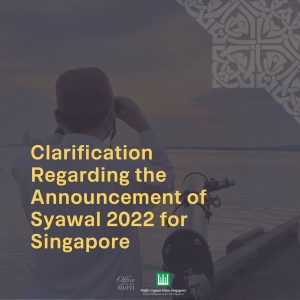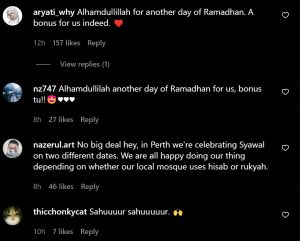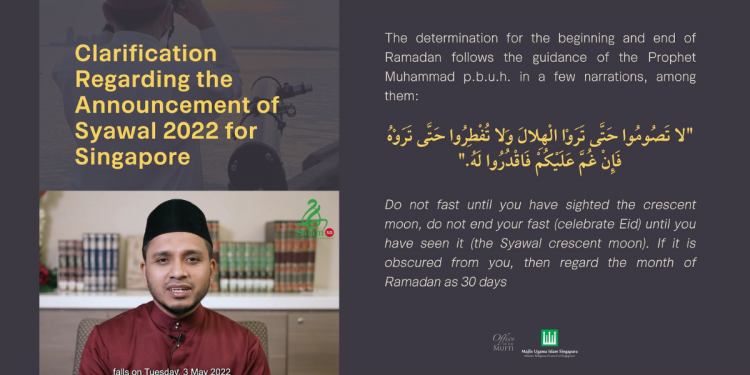“Do not fast until you have sighted the crescent moon, do not end your fast (celebrate Eid) until you have seen it (the Syawal crescent moon). If it is obscured from you, then regard the month of Ramadan as 30 days.” – the Prophet Muhammad p.b.u.h
لا تَصُومُوا حَتَّى تَرَوْا الْهِلالَ وَلا تُفْطِرُوا حَتَّى تَرَوْهُ فَإِنْ غُمَّ عَلَيْكُمْ فَاقْدُرُوا لَهُ.”
These are the words of the Prophet that guide Muslims around the world during fasting month.
2nd May or 3rd May?
For the first time in a long time, Singapore will not be celebrating Hari Raya Puasa on the same day as Malaysia, Indonesia, and Brunei. The 3 latter countries will be celebrating Hari Raya today. Muslims in Singapore, on the other hand, will still be fasting from dawn till dusk today and only celebrating Hari Raya tomorrow.
2022 might be the first time that Singapore and Malaysia have two differing dates for Hari Raya.
Also note the differing authority: Malaysia's Hari Raya is traditionally announced by the Keeper of the Royal Seal.
In Singapore, it's the Mufti of Singapore. pic.twitter.com/ZyMv0w4Bw5
— The Viscount Bukit Panjang (@theViscountBP) May 1, 2022
The reasons for the difference in dates has been the subject of a lot of public attention. This tweet by Jamie has garnered almost 6,000 retweets in less than 24 hours.
The Mufti explains
The Mufti, Dr Nazirudin Mohd Nasir, issued a comprehensive clarification earlier today on the difference in the dates and the process by which the date was arrived at.

First, the Mufti explained, guidance must be taken from the words of Prophet Muhammad.
1. The determination for the beginning and end of Ramadan follows the guidance of the Prophet Muhammad p.b.u.h. in a few narrations, among them:
لا تَصُومُوا حَتَّى تَرَوْا الْهِلالَ وَلا تُفْطِرُوا حَتَّى تَرَوْهُ فَإِنْ غُمَّ عَلَيْكُمْ فَاقْدُرُوا لَهُ.”
Do not fast until you have sighted the crescent moon, do not end your fast (celebrate Eid) until you have seen it (the Syawal crescent moon). If it is obscured from you, then regard the month of Ramadan as 30 days.2. Based on the guidance of the Prophet p.b.u.h., scholars use two primary criteria, hisab (calculation based on the science of astronomy) and rukyah (the sighting of the moon) to determine whether the crescent moon is visible.
Difficult for the Syawal Crescent Moon to be visible in Singapore
The Mufti then noted that it was generally difficult for the Syawal cresent moon to be spotted in Singapore due to cloudy conditions. At sunset on the 29th day of Ramadan, they were not able to physically see the Syawal moon from Singapore.
3. In Singapore, it is generally extremely difficult for the crescent moon to be visible because of its climatic conditions, which is often cloudy. Thus, Singapore uses the commonly agreed criteria used by the MABIMS countries (Brunei, Indonesia, Malaysia dan Singapura) in determining the sighting of the crescent moon. This methodology is known as imkan ar-rukya.
4. This imkan ar-rukya criteria has been reviewed and refined by MABIMS countries since 2017, and finally revised in 2021, based on more than 700 data points of crescent sightings from around the world. The new criteria considers two parameters during sunset on the 29th day of the month – the elevation of the crecent moon (which must exceed three degrees) and the degree of elongation of the sun and the moon (which must exceed 6.4 degrees).
5. Based on these criteria the crescent moon was not visible in Singapore at sunset on 29 Ramadan. For confirmation, the Office of the Mufti together with experts in the science of falak attempted to conduct a physical sighting of the crescent moon, which was unsuccessful (i.e. the new moon was not visible). During the sighting it was also clear that the western horizon was overcast with clouds.
It was noted that some of our neighbouring countries were able to physically see the Syawal crescent moon
6. The religious authorities of the other MABIMS countries reported that the crescent moon was visible in their sightings at only certain sites in their own territories.
7. Although the results differed, all MABIMS countries adopted the method of determination with was based on the principles and guidance of the Prophet p.b.u.h, and their individual results are valid in their respective contexts, and everyone adheres to the principle that Ramadan in each country did not exceed 30 days.
This has happened before
The Mufti also shared about how this had happened before in history by citing the example of how people in different cities fasted on different days based on the differences in sighting the crescent moon in the cities of Syam and Madinah.
8. This difference in determining the beginning or end of Ramadan was also narrated by Imam Muslim among the companions of the Prophet who were in different cities, where Mu’awiyah fasted on a Friday whereas the rest fasted on a Saturday, based on the differences in sighting the crescent moon in the cities of Syam and Madinah. When queried why they did not simply standardize with Mu’awiyah to regularize the fasting period, Ibn ‘Abbas replied that such determination (in following the geographical location of a person) was what had been taught by the Prophet p.b.u.h., even though it would cause different start and end dates for Ramadan among Muslims.
9. In this region, differences in the start of the Hijri calendar have occurred very frequently in the past (as recently as 2014, 2015, 2016, 2017 and 2021) and may well occur again in future. Thus, in 2022, not all countries in the world (including Muslim-majority countries) celebrate Ramadan and Aidilfitri on the same dates. Indeed, the crescent moon has also not been sighted in a few other countries, and as a consequence, they will be celebrating Aidilfitri on Tuesday 3 May, like Singapore. For as long as we hold true to the principles of our faith and the guidance of the Prophet Muhammad p.b.u.h, s.a.w., as mentioned above, differences in the determination of the Islamic calendar is something which is neither unexpected nor alarming.
In closing, the Mufti hoped that all Muslims will continue to find solace and peace in worship in the month of Ramadan.

Reactions
Many in the comments section of MUIS’ Instagram post, which was published just after midnight on 2 May 2022, expressed gratitude for the Mufti’s thorough explanation.


Others, like the creator of this meme below, took the opportunity to wish Muslims in Malaysia and Indonesia first.

Suhtama, a popular content creator on Tik Tok with more than 55,000 followers, posted a short video about how Singaporeans who hoped to do last minute shopping across the causeway will have their plans thwarted because the Malaysians are celebrating Hari Raya today.
@suhtama
Whether you are celebrating today or tomorrow, Wake Up Singapore would like to take this opportunity to wish you a Selamat Hari Raya. We wish you joy, peace, health and justice to you and your loved ones.
Since you have made it to the end of the article, follow Wake Up Singapore on Telegram!





